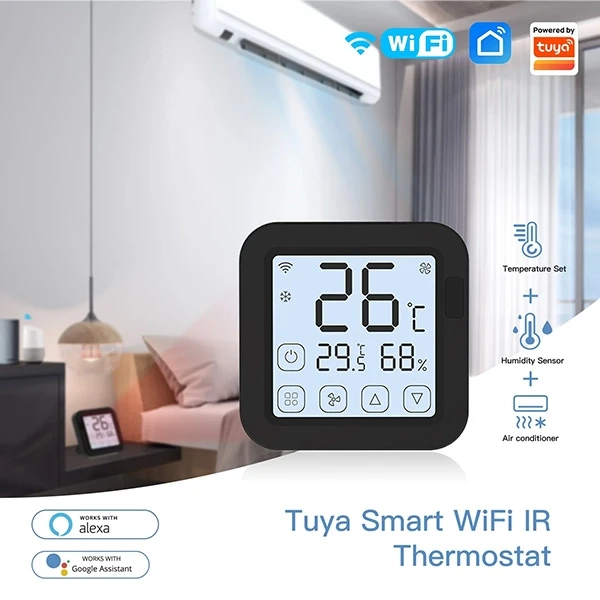WiFi temperature sensors have emerged as crucial tools in various fields, from smart homes to industrial automation. These sensors provide real-time temperature monitoring and data transmission over WiFi networks, enabling remote access and control.
This article explores the features, types, applications, benefits, and future trends of WiFi temperature sensors, highlighting their transformative impact on modern technology.
Understanding WiFi Temperature Sensors
WiFi temperature sensors are devices designed to measure ambient temperature and transmit the data wirelessly over a WiFi network. These sensors typically consist of a temperature-sensing element, a microcontroller, and a WiFi module.
The temperature data collected by the sensor is processed and sent to a central system or cloud-based platform, where it can be accessed remotely via computers, smartphones, or other internet-connected devices.
Key Features of WiFi Temperature Sensors
Wireless Connectivity: Utilizing WiFi technology, these sensors can transmit data over long distances without the need for physical connections, facilitating ease of installation and flexibility in placement.
Real-Time Monitoring: WiFi temperature sensors provide real-time temperature data, enabling immediate detection and response to temperature fluctuations.
Remote Access: Data from the sensors can be accessed from anywhere with an internet connection, allowing for remote monitoring and management.
Alerts and Notifications: Many WiFi temperature sensors are equipped with alert functionalities that send notifications via email, SMS, or mobile apps when temperature thresholds are exceeded.
Data Logging: These sensors often come with data logging capabilities, recording historical temperature data for analysis and record-keeping.
Battery Operation: Many models are battery-operated, ensuring continuous operation even in areas without access to power outlets.
Types of WiFi Temperature Sensors
Indoor WiFi Temperature Sensors: Designed for indoor environments, these sensors are used in homes, offices, and commercial buildings to monitor indoor climate conditions.
Outdoor WiFi Temperature Sensors: Built to withstand harsh outdoor conditions, these sensors are used for monitoring temperature in external environments, such as weather stations and agricultural fields.
Industrial WiFi Temperature Sensors: Engineered for industrial applications, these sensors are robust and capable of operating in extreme temperatures and demanding conditions.
Multi-Sensor Units: These devices incorporate additional sensors, such as humidity, pressure, or motion sensors, providing comprehensive environmental monitoring.
Smart Home Integration Sensors: These sensors are designed to integrate seamlessly with smart home systems, allowing for automated climate control and energy management.
Applications of WiFi Temperature Sensors
Smart Homes: WiFi temperature sensors play a pivotal role in smart home ecosystems, enabling automated climate control, energy efficiency, and enhanced comfort through integration with home automation systems.
Healthcare: In medical settings, these sensors monitor the temperature of critical areas, such as patient rooms, laboratories, and storage facilities for temperature-sensitive medications and vaccines.
Industrial Automation: WiFi temperature sensors are used in manufacturing and industrial processes to monitor equipment and environmental conditions, ensuring optimal operation and preventing overheating or other temperature-related issues.
Agriculture: These sensors are utilized in agriculture to monitor and manage the temperature of greenhouses, storage facilities, and livestock environments, promoting better crop yield and animal health.
Food and Beverage: In the food industry, WiFi temperature sensors ensure that storage and transportation conditions meet safety standards, preventing spoilage and ensuring product quality.
Data Centers: Temperature monitoring in data centres is critical for maintaining the performance and longevity of servers and other IT equipment. WiFi temperature sensors provide real-time data to prevent overheating and optimize cooling systems.
Environmental Monitoring: These sensors are used in environmental monitoring applications to track temperature changes in natural habitats, research stations, and weather observation sites.
Benefits of WiFi Temperature Sensors
Improved Efficiency: By providing real-time temperature data, these sensors enable prompt response to temperature changes, improving efficiency in various applications.
Enhanced Safety: Continuous monitoring and alerts help prevent potential hazards caused by temperature fluctuations, such as equipment overheating or food spoilage.
Cost Savings: Automated temperature monitoring reduces the need for manual checks, lowering labor costs and minimizing the risk of costly temperature-related damage.
Convenience: The ability to access temperature data remotely offers convenience and flexibility, allowing users to monitor conditions from anywhere.
Data-Driven Decisions: Historical data logging and analysis capabilities help identify trends and make informed decisions, enhancing overall operational effectiveness.
Scalability: WiFi temperature sensors can be easily scaled to cover large areas or multiple locations, making them suitable for both small and large-scale applications.
Future Trends and Innovations
Integration with IoT: The integration of WiFi temperature sensors with the Internet of Things (IoT) will continue to expand, creating more interconnected and intelligent systems for automated control and monitoring.
Advanced Analytics: The use of advanced analytics and machine learning algorithms will enhance the predictive capabilities of these sensors, enabling more proactive and preventative measures.
Enhanced Battery Life: Innovations in battery technology will lead to longer-lasting, more efficient WiFi temperature sensors, reducing the need for frequent maintenance and replacements.
Miniaturization: Continued miniaturization of sensor components will result in smaller, more discreet sensors that can be placed in more challenging environments or integrated into compact devices.
Improved Accuracy: Advances in sensor technology will enhance the accuracy and reliability of temperature measurements, providing more precise data for critical applications.
Environmental Sustainability: The development of eco-friendly materials and energy-efficient designs will contribute to more sustainable and environmentally friendly sensor solutions.
Conclusion
WiFi temperature sensors are transforming the way we monitor and manage temperature across various applications. Their ability to provide real-time data, remote access, and automated alerts makes them invaluable tools in enhancing efficiency, safety, and convenience.
As technology continues to evolve, the capabilities and applications of WiFi temperature sensors will expand, driving innovation and improving outcomes in numerous fields.
Understanding the features, types, and benefits of these sensors can help users leverage their full potential, making informed decisions to optimize performance and achieve their goals in an increasingly connected world.


